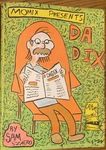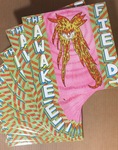
It's about time... for the new Now. The twelfth issue is a mind bender with perhaps the widest ranging material yet. From the rhythmic abstractions of Cynthia Alfonso's "untitled" to the old school satire, "The Cartoonist" by Matt Lawton and Peter Bagge, this issue spans the generations and the form itself. The æsthetic center on which the issue pivots is Kayla E.'s "Precious Rubbish", a series of post-modern mash-ups that bring together a variety of texts ranging from personal reminiscences to the Old and New Testaments and combining them with her personal, signature-style comics, here largely derived from a selection of old school comic book pages, including several from Matt Baker's Canteen Kate (!).
Many readers will get their first look at the piercingly acute and dizzyingly strange artwork of Bhanu Pratap in his story, "Big Head Pointy Nose" which is the first work of his we've seen in color.
Francois Vigneault's "The Bird Is Gone" is a moving tale of the passing of the Passenger Pigeon. No matter how many times you hear, see or read the facts that are related in this story, it always boggles the mind.
For us here at Copacetic, #12's highlight is Tim Lane's "Li'l Stevie", a hybrid work that seems to synthesize Chris Ware’s Jimmy Corrigan and Peter Blegvad’s Leviathan – with a dash of Al Columbia’s Pim & Francie – and then graft it all onto Ernie Bushmiller’s early period Fritzy Ritz and Nancy in order to create a dark, drunken and twisted, but pathos laden – and still very Tim Lane – Golden Age comics take on... Steve McQueen's childhood. This work won't appeal to everyone, but those who think this sounds up their alley won't want to miss it.
Another great issue of Now!
Now out of print! BUT, we have ONE copy remaining...

Here's a volume that's not for the faint of heart. In these 88, oversize, A4 pages, J. Webster Sharp applies her dazzling stippling technique (think Drew Friedman doing storyboards for Eraserhead) to translating the psychological underpinnings of the mental health issues that occupied Edwardian era egalitarian, George Ives, whose obsessions led him to assemble a massive hoard of newspaper clippings that he then collected into a lengthy series of scrapbooks over a period of 50 years (think Henry Darger as a scrapper). Hallucinogenic is the word that first comes to mind while scanning these images. Also, disturbing.
At the conclusion of the volume, hand written transcriptions of some of the newspaper clippings that inspired the comics are appended.
To get a better idea of what's actually in store here, check out our Tumblr post on the book, HERE (which is made up of some of the tamer images, just FYI)
Anyone interested in some background on the creation of this work is encouraged to tune in to this 45-minute interview with J. Webster Sharp hosted by publisher Avery Hill.
Review Quotes:
"There's no one else making comics the way she is, and there's no mistaking one of her comics for somebody else's. Her concerns, fixations and flights of fancy are more or less entirely her own, and her means of communicating them are likewise utterly unique." -- Ryan Carey, The Comics Journal
"Confronting taboos with surgical skill, an anatomist's understanding and a detective's passion, the auteur has crafted here an emotional experience both enticingly lovely and yet intrinsically profane." -- Now Read This
"It has detail, it has passion and courage and guts, and wit and intelligence. It's daring and takes risk in both subject matter and execution. It also makes you unnerved, uncomfortable, intrigued, repulsed, excited. It's singular and unique." -- Paul Ashley Brown, Comic Bits Online
J. Webster Sharp began her professional art career as a portrait painter, and she also explored textile sculpture, collage and drawing. Having always been a lover of comics she committed herself to a career in sequential art in May 2021. She's inspired by the strange, eccentric and the psychology behind unusual imagery.

Zine Panique, Extra Pellicula (Outside the Movie) is listed as #1, implyting more to come...? This is a cool concept and a good issue, so it seems like it "has legs"
And the concept? Each contributor picks a film and imagines an extra scene, in the form of a short comic. In the 60 glossy pages of this square bound softcover, the stories unfold in black & white, duo-tone and full color. Some are wordless, some are in English and somes are in French, and the publisher has thoughtfully included an insert sheet providing a panel-by-panel translation of the French language works into English, so it's a simple matter those Anglophones non-conversent en français to follow along.
Front and back covers by Sammy Harkham (and back cover is a full color 12-panel comic!)
Comics: by Ethan Llewellyn, Matthew Thurber, Andres Magan, Steve Grove, David Enos, Léo Quievreux x Samplerman, Jemma Sharp (aka J. Webster Sharp), Corinne Halbert, David Brohet, Telmo Braun and Masse
And, the chosen films for which the extra scene has been imaged are: Edwin S. Poeter's Alice's Adventures in Wonderland (the first, from 1910); Tod Browning's Freaks; Fellini's La Notti di Cabiria; John Sturges''s The Great Escape; Jaques Rivette's Celine and Julie Go Boating; Ken Russell's The Devils; Nicholas Gessner's The Little Girl Who Lies Down the Lane; Robert Altman's 3 Women; Fellini Satyricon; Eraserhead; Transpotting; and Tampopo.
Added fun bonus: match the comic makers to the films, then check your guesses once it arrives in the mail.
NOTE: Limited to 300 copies (hand numbered!)
LIMIT: One copy per customer.










